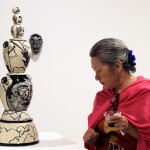Although you won’t find them memorialized in a street name, there are three Idyllwild pioneers I regard most highly: George Hannahs, Claudius Emerson, and Ernest Maxwell. After profiling Hannahs and Maxwell recently, it’s time for me to focus on Emerson.
A recent arrival in San Jacinto from California’s Central Valley, Claudius at 28 married Zelma Schultz, bought a grocery store, then got into the banking business. He, along with Hannahs, became prominent on the local school board, and in 1910 they teamed with Diamond Valley rancher Angelo Domenigoni to form their own bank.
Emerson traveled to Idyllwild as early as 1901, often bringing youth groups up on camping trips. In 1911 he and Zelma spent a vacation with their five children at Domenigoni’s ranch in lower Strawberry Valley and enjoyed it so much they returned for a month the next year.
By 1917, several summers of such vacations had set Claudius Emerson to dreaming. “Idyllwild-in-the-Pines,” as it was advertised, had become a sleepy resort, an inn luxurious enough for its era and location, but not a prime preoccupation of its owners, Los Angeles land developers Frank Strong and George Dickinson, who had leased out its management.
Claudius led a group of investors, including his brother John, in buying the Idyllwild Inn and 1,000 acres surrounding it — essentially what we know as central Idyllwild — but soon bought out his partners. With five children to raise, he had a vision of building a family-friendly community, with wholesome enterprises, vacation homes, and perhaps a year-round resident population.
His first step was to attract visitors to see the possibilities. Despite a brief hiatus repairing damage from a 6.9 earthquake near San Jacinto in 1918, he substantially upgraded the resort’s amenities. In particular, the tennis courts at the inn and the 9-hole golf course on the road from Hemet (today’s Tollgate) attracted tournament competitors statewide.
Second, he started giving away land to Boy Scouts (camps Emerson & Tahquitz) and religious organizations (Idyllwild Pines), as well as to Riverside County (park and campground).
The third arm of Emerson’s strategy was to subdivide and market lots for vacation homes through a holding company, Idyllwild Inc. He built a real estate sales and insurance office (now Idyllwild Realty’s Log Cabin office) and launched a summertime newspaper, Idyllwild Breezes, to publicize Idyllwild.
Anything but a high-pressure salesman, Emerson’s style was described by Florence Casebeer. She and her husband Arthur were personally welcomed by him on arrival at the inn, then enjoyed a good dinner, the warmth of the huge fireplace in the lobby, and a night’s sleep in one of the cabins. Encountering the Casebeers the next day, Emerson suggested that the two of them take a stroll down the long, snowy path across Strawberry Creek.
When they returned, Emerson simply asked what they found. Florence answered, “What I’ve been searching for ever since I left the Colorado mountains.” To which Emerson replied, “Show it to me. Perhaps we can make your dream come true right here in the San Jacinto Mountains.” And it did, for the next 46 years, in the Casebeer home on South Circle Drive.
The 1920s boom tempted Emerson to keep investing. He bought 450 acres on Domenigoni Flat, intending to dam the creeks to form “Lake Idyllwild,” even build an airfield. But as lakefront lots were selling “like hotcakes” in 1929, the economy suddenly collapsed, bankrupting Idyllwild Inc. by 1936. The Emersons departed Idyllwild in 1938, leaving their son-in-law, Gregory Esgate, as manager trying to salvage the inn.
It was a tragic defeat for Emerson, but not for Idyllwild. The mere existence of a settled community here remains a lasting tribute to his vision and energy.










